en
names in breadcrumbs

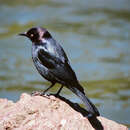
'''Euphagus cyanocephalus, tamién conocíu como tordu güeyu mariellu,[2] ye una especie d'ave paseriforme de la familia Icteridae. Ye nativu de Les Bahames, Canadá, Islles Turques y Caicos, Estaos Xuníos, Méxicu y Guatemala.[1] El so hábitat natural compónse de praderíes y pacionales, mariña arenosa sableres, bancos de sable, poces intermareales.[1]
 Esta páxina forma parte del wikiproyeutu Aves, un esfuerciu collaborativu col fin d'ameyorar y organizar tolos conteníos rellacionaos con esti tema. Visita la páxina d'alderique del proyeutu pa collaborar y facer entrugues o suxerencies.
Esta páxina forma parte del wikiproyeutu Aves, un esfuerciu collaborativu col fin d'ameyorar y organizar tolos conteníos rellacionaos con esti tema. Visita la páxina d'alderique del proyeutu pa collaborar y facer entrugues o suxerencies. '''Euphagus cyanocephalus, tamién conocíu como tordu güeyu mariellu, ye una especie d'ave paseriforme de la familia Icteridae. Ye nativu de Les Bahames, Canadá, Islles Turques y Caicos, Estaos Xuníos, Méxicu y Guatemala. El so hábitat natural compónse de praderíes y pacionales, mariña arenosa sableres, bancos de sable, poces intermareales.
Y. cyanocephalus (machu).
Y. cyanocephalus (fema).
Y. cyanocephalus (fema).
Aderyn a rhywogaeth o adar yw Tresglen Brewer (sy'n enw benywaidd; enw lluosog: tresglod Brewer) a adnabyddir hefyd gyda'i enw gwyddonol Euphagus cyanocephalus; yr enw Saesneg arno yw Brewer’s blackbird. Mae'n perthyn i deulu'r Tresglod (Lladin: Icteridae) sydd yn urdd y Passeriformes.[1]
Talfyrir yr enw Lladin yn aml yn E. cyanocephalus, sef enw'r rhywogaeth.[2]
Mae'r tresglen Brewer yn perthyn i deulu'r Tresglod (Lladin: Icteridae). Dyma rai o aelodau eraill y teulu:
Rhestr Wicidata:
rhywogaeth enw tacson delwedd Casig Para Psarocolius bifasciatus Casig penwinau Psarocolius wagleri Euryn Martinique Icterus bonana Euryn y Gogledd Icterus galbula Euryn ymylwyn Icterus graceannae Gregl y Gorllewin Quiscalus nigerAderyn a rhywogaeth o adar yw Tresglen Brewer (sy'n enw benywaidd; enw lluosog: tresglod Brewer) a adnabyddir hefyd gyda'i enw gwyddonol Euphagus cyanocephalus; yr enw Saesneg arno yw Brewer’s blackbird. Mae'n perthyn i deulu'r Tresglod (Lladin: Icteridae) sydd yn urdd y Passeriformes.
Talfyrir yr enw Lladin yn aml yn E. cyanocephalus, sef enw'r rhywogaeth.
Der Purpurstärling (Euphagus cyanocephalus) ist ein nordamerikanischer Singvogel aus der Familie der Stärlinge (Icteridae).
Im Prachtkleid ist das gelbäugige Männchen völlig schwarz gefärbt mit purpurviolettem Schimmer an Kopf und Hals sowie grünlichem Glanz am Körper. Dagegen schillert es im Schlichtkleid weniger stark. Das Weibchen ist oberseits graubraun und unterseits etwas heller gefärbt und hat braune Augen.
Der Purpurstärling brütet in Südkanada, weiten Teilen der USA und überwintert vom Mittleren Westen und der südlichen USA bis Mexiko. Er bewohnt Wiesen, Felder und Stadtgebiete. Besonders im Osten ist er ein häufiger Gast in Gärten. Wo sich das Verbreitungsgebiet mit dem des Purpur-Grackels überschneidet, lebt er eher in offenen Gegenden, während der Grackel Lebensräume in der Stadt oder am Stadtrand bevorzugt.
Der Vogel schließt sich gern, auch mit anderen Arten wie der Gelbschnabelelster, zu großen Schwärmen zusammen. Durch das massenhafte Auftreten wird er manchmal als Landplage angesehen. Er sucht im flachen Wasser oder am Boden nach Sämereien und Wirbellosen. Manchmal werden Insekten im Flug gefangen.
Der Purpurstärling nistet in lockeren Kolonien, die einige wenige, aber auch bis zu 100 Brutpaare umfassen können. Das Weibchen legt in ein unförmiges, ballartiges Nest in einem Busch oder Baum drei bis sieben Eier, welche etwa zwei Wochen lang bebrütet werden. Nach rund zwei Wochen werden die Jungen flügge.
Der Purpurstärling (Euphagus cyanocephalus) ist ein nordamerikanischer Singvogel aus der Familie der Stärlinge (Icteridae).
Brewer's blackbird (Euphagus cyanocephalus) is a medium-sized New World blackbird. It is named after the ornithologist Thomas Mayo Brewer.
Adult males have black plumage with an iridescent purple head and neck and glossy bluish-green highlights on the rest of the body. The feet and legs are black and the eye is bright yellow. The female is brownish-grey with slight hints of the male's iridescence. The female's eye is dark brown, while the male's is bright yellow. Overall, they resemble the eastern member of the same genus, the rusty blackbird; the Brewer's blackbird, however, has a shorter bill and the male's head is iridescent purple.[2] This bird is often mistaken for the common grackle but has a shorter tail. The call is a sharp check which is also distinguishable. This bird is in a different family from the Eurasian blackbird.
Their breeding habitat is open and semi-open areas, often near water, across central and western North America. They are also very common in parking lots, and easily acclimate to the presence of people.[5]
These birds are often permanent residents in the west. Other birds migrate to the Southeastern United States and Mexico in Spring. The range of this bird has been expanding east in the Great Lakes region.[6][5]
They forage in shallow water or in fields, mainly eating seeds and insects, some berries. They sometimes catch insects in flight. They feed in flocks outside of the breeding season, sometimes with other blackbirds.[5] In marshy areas, they are known to stand on aquatic plants and wade in shallow water to catch insects. Some have even been known to eat smaller mammals, amphibians, and the nestlings of other birds.[7][5]
Their clutch size can vary, usually between 3–7.[5] Eggs are usually a tan color with darker speckles throughout to allow for camouflage.[8] The female bird primarily incubates for 12–14 days.[5]
Nests are not built in isolation, but in colonies of up to 30 pairs.[5] Pairs prefer to nest in areas that are around 20–40' in treetops. However, colonies that live near water may also nest in reeds and other freshwater plants.[7] Nests are made from nearby material such as reeds, sticks and hair. They are built by the female in a cup-like shape and are bonded with mud or other securing substances.[7] The color of the nest usually matches the coloration of the eggs and the surrounding environment as it is crucial to survival.[9]
The Brewer's blackbird (Euphagus cyanocephalus) is protected in the United States under the Migratory Bird Treaty Act of 1918,[10] however exceptions are granted under 50 CFR part 21 (2014) [11] for animals committing or about to commit depredations upon ornamental or shade trees, agricultural crops, livestock, or wildlife, or when concentrated in such numbers and manner that they are a health hazard or other nuisance.
Brewer's blackbird calling
Brewer's blackbird (Euphagus cyanocephalus) is a medium-sized New World blackbird. It is named after the ornithologist Thomas Mayo Brewer.
La Purpurkapa eŭfago (Euphagus cyanocephalus) estas mezgranda birdospecio de la familio de Ikteredoj kaj genro de Eŭfagoj, kiuj enhavas nur du speciojn.
Plenkreskulo havas pintakran bekon. Maskla plenkreskulo havas tre brilnigran plumaron; la ino estas malhelgriza. La masklo havas brilflavan okulon; tiu de la ino estas malhela. Ili similas al la orienta membro de la sama genro, nome Rusta eŭfago; tamen tiu ĉi birdo havas pli mallongan bekon kaj la kapo de la masklo estas irize purpura, kio nomigas la specion kaj en la komuna nomo kaj en la latina scienca nomo kie cyanocephalus estas kunmetaĵo de du radikoj el la antikva greka signife respektive “violblua, purpura” kaj “kapo”. Tiu ĉi birdo estas ofte misprenita por la Komuna kviskalo sed ĝi havas pli mallongan voston. La alvoko estas akra “ĉek” kiu estas ankaŭ distingebla. Tiu ĉi birdo estas de tute diferenca familio el la ankaŭ tutnigra Merlo.
Ties reprodukta habitato estas malfermaj kaj duonmalfermaj areoj, ofte ĉe akvo, tra centra kaj okcidenta Nordameriko. La tasforma nesto povas situi en diversaj lokotipoj: en arbo, en alta herbo aŭ en klifo. Ili ofte nestumas en kolonioj.
Tiuj birdoj estas ofte konstantaj loĝantaj birdoj en okcidento. Aliaj birdoj migras al sudorienta Usono kaj Meksiko.
Ili manĝas ĉe neprofunda akvo aŭ en kamparo, ĉefe nutrante sin el semoj kaj insektoj, krom beroj. Ili foje kaptas insektojn dumfluge. Ili manĝas en aroj for de la reprodukta sezono, foje en miksitaj kunmanĝantaroj kun aliaj ikteredoj.
La teritorio de tiu birdo etendiĝis orienten al la regiono de la Grandaj Lagoj.
Tiu birdo en Usono ricevis la nomon Brewer's Blackbird laŭ la ornitologo Thomas Mayo Brewer.
La Purpurkapa eŭfago (Euphagus cyanocephalus) estas protektita laŭ la Traktato de Migrantaj Birdoj de 1918.[1]
La Purpurkapa eŭfago (Euphagus cyanocephalus) estas mezgranda birdospecio de la familio de Ikteredoj kaj genro de Eŭfagoj, kiuj enhavas nur du speciojn.
El turpial ojiclaro (Euphagus cyanocephalus), también conocido como tordo ojo amarillo o zanate de Brewer,[2][3] es una especie de ave paseriforme de la familia Icteridae propia de América del Norte. Es nativo de Canadá, Estados Unidos y México, aunque puede aparecer como divagante en Bahamas, las islas Turcas y Caicos y Guatemala.[1] Sus hábitats naturales son las praderas y pastizales, playas arenosas, bancos de arena, pozas intermareales.[1]
El turpial ojiclaro (Euphagus cyanocephalus), también conocido como tordo ojo amarillo o zanate de Brewer, es una especie de ave paseriforme de la familia Icteridae propia de América del Norte. Es nativo de Canadá, Estados Unidos y México, aunque puede aparecer como divagante en Bahamas, las islas Turcas y Caicos y Guatemala. Sus hábitats naturales son las praderas y pastizales, playas arenosas, bancos de arena, pozas intermareales.
E. cyanocephalus (macho).
E. cyanocephalus (hembra).
E. cyanocephalus (hembra).
Euphagus cyanocephalus Euphagus generoko animalia da. Hegaztien barruko Icteridae familian sailkatua dago.
Euphagus cyanocephalus Euphagus generoko animalia da. Hegaztien barruko Icteridae familian sailkatua dago.
Peltoturpiaali (Euphagus cyanocephalus) on Pohjois-Amerikassa tavattava turpiaaleihin kuuluva varpuslintu.
Peltoturpiaali on 21–25 cm pituinen. Peltoturpiaalikoiras on yksivärisen musta, mutta höyhenet voivat kiiltää myös sinisen ja vihreän sävyissä. Nuoret koiraat ovat ruskehtavan mustia eivätkä yhtä kiiltäviä kuin aikuiset koiraat. Koiraan silmän iiris on väriltään valkoinen, mikä erottaa sen korpiturpiaalista (Euphagus carolinus). Korpiturpiaalin pää on myös vihreämpi kuin peltoturpiaalilla, jolla se on hohteeltaan sinivioletimpi. Naaraslinnut ovat koiraita vaaleampia ja ruskeampia ja tummimmillaan siivistä.[2][3][4][5]
Peltoturpiaalien pesimäalue ulottuu Kanadassa ja Yhdysvalloissa Suurilta tasangoilta länteen ja etelään aina Meksikon pohjoisosiin asti. Laji talvehtii Yhdysvaltain eteläosissa ja Meksikossa, mutta osa linnuista jää pohjoisemmaksikin. Linnun elinympäristöä ovat avoimet ja puoliavoimet maastot kuten laidunmaat, joilla kasvaa myös pensaikkoa, soiden reunamat ja metsäpaloista aiheutuneet aukiot metsissä. Lisäksi peltoturpiaaleja tavataan myös puistoissa, puutarhoissa ja golfkentillä.[2][3][4][5]
Peltoturpiaalit elävät pienissä ryhmissä. Talvisin niitä näkee yhdessä muiden turpiaalien kanssa sekaparvissa. Laji käyttää ravintonaan pääasiassa siemeniä, joita se etsii maasta. Lisäksi lintu syö myös hyönteisiä, joita se pyydystää ilmasta.[2][3][4]
Peltoturpiaalit voivat pesiä pareittain tai löyhissä kolonioissa, joissa voi olla pareja muutamasta yli sataan. Kuppimainen kasvimateriaalista rakennettu pesä voi sijaita puussa, pensaikossa tai korkeassa ruohikossa. Naaras rakentaa pesän ja munii siihen kolmesta seitsemään vaalean harmahtavaa täplikästä munaa. Naaras hautoo munat yksin, mutta koiras ruokkii naaraan ja poikaset. Peltoturpiaaliparilla voi olla kaksi pesintää kauden aikana.[2][3][5]
Peltoturpiaali (Euphagus cyanocephalus) on Pohjois-Amerikassa tavattava turpiaaleihin kuuluva varpuslintu.
Euphagus cyanocephalus
Le Quiscale de Brewer (Euphagus cyanocephalus) est une espèce d'oiseau d'Amérique.
Son nom français rend hommage à l'ornithologue Thomas Mayo Brewer.
Les mâles adultes ont un plumage noir et les plumes sont irrisées sur le dessus de la tête. Le plumage des femelles est gris foncé.
Leur zone de reproduction est les régions ouvertes et semi-ouvertes souvent près de l'eau au centre et dans l'ouest de l'Amérique du Nord. Le couple peut nicher dans un arbre, une prairie ou une falaise, souvent en colonies.
Cet oiseau se nourrit d'insectes, de graines et de baies.
Euphagus cyanocephalus
Une quiscale de Brewer femelle visite un parc de San Francisco.Le Quiscale de Brewer (Euphagus cyanocephalus) est une espèce d'oiseau d'Amérique.
Son nom français rend hommage à l'ornithologue Thomas Mayo Brewer.
Geltonakis trupialas (lot. Euphagus cyanocephalus, angl. Brewer's Blackbird, vok. Purpurstärling) – trupialinių (Icteridae) šeimos paukštis. Lietuvoje neperi, rudenį ir žiemą stebėti atsitiktinai užklydę paukščiai.
Geltonakis trupialas (lot. Euphagus cyanocephalus, angl. Brewer's Blackbird, vok. Purpurstärling) – trupialinių (Icteridae) šeimos paukštis. Lietuvoje neperi, rudenį ir žiemą stebėti atsitiktinai užklydę paukščiai.
Paukščio čiulbesysDe Brewers troepiaal (Euphagus cyanocephalus) is een zangvogel uit de familie Icteridae (troepialen).
Purpurhodetrupial (Euphagus cyanocephalus) er en fugl i trupialfamilien.
Purpurhodetrupial (Euphagus cyanocephalus) er en fugl i trupialfamilien.
Kacykarzyk purpurowy[3] (Euphagus cyanocephalus) – gatunek ptaka z rodziny kacykowatych (Icteridae). Często spotykany w dużych stadach razem z epoletnikiem krasnoskrzydłym.
Długość ciała samców 23 cm, masa ciała 60–73 g; długość ciała samic 21 cm, masa ciała 50,6–67 g[4]. Czarny, z purpurowym połyskiem na głowie i zielonym na tułowiu. Dziób stożkowaty, ostro zakończony. Tęczówki kremowobiałe do jasnożółtych. Samica szarobrązowa, jaśniejsza na głowie i szyi; tęczówki ciemnobrązowe. Młode ptaki podobne do samicy. Młode samce czarniawe, z szarą brwią oraz skąpymi, szarymi prążkami na grzbiecie i piersi.
Tereny otwarte i zadrzewienia, na zachód od środkowej i południowo-środkowej części Ameryki Północnej. Zimę spędza w środkowo-zachodniej i południowej części Ameryki Północnej.
Kacykarzyk purpurowy (Euphagus cyanocephalus) – gatunek ptaka z rodziny kacykowatych (Icteridae). Często spotykany w dużych stadach razem z epoletnikiem krasnoskrzydłym.
Prärietrupial[2] (Euphagus cyanocephalus) är en fågel i familjen trupialer inom ordningen tättingar.[3] Den häckar i västra Kanada och västra USA och flyttar vintertid så långt söderut som till södra Mexiko.[3] IUCN kategoriserar arten som livskraftig.[1]
Prärietrupial (Euphagus cyanocephalus) är en fågel i familjen trupialer inom ordningen tättingar. Den häckar i västra Kanada och västra USA och flyttar vintertid så långt söderut som till södra Mexiko. IUCN kategoriserar arten som livskraftig.
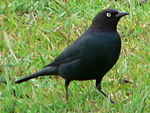



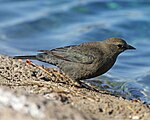
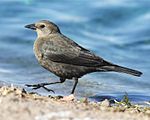
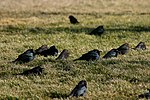
Euphagus cyanocephalus là một loài chim trong họ Icteridae.[2]
Euphagus cyanocephalus (Wagler, 1829)
Охранный статусБлестящий малый трупиал[1] (лат. Euphagus cyanocephalus) — певчая птица семейства трупиаловых, обитающая в Северной Америке.
В брачном наряде самец полностью окрашен в чёрный цвет с пурпурно-фиолетовым отливом на голове и шее, а также зеленоватым отблеском на теле. Радужины жёлтые. В зимнем наряде его оперение переливается красками меньше. У самки оперение верхней части тела бурого цвета, нижняя часть тела окрашена немного светлее. Радужины коричневые.
Блестящий малый трупиал распространён на юге Канады и в США. На зимовку вид мигрирует в Средний Запад и на юг США до Мексики. Он населяет луга, поля и городские ландшафты. Особенно на востоке это частый гость в садах. Где область распространения перекрывается областью распространения обыкновенного гракла, птица живёт скорее на открытых ландшафтах, во то время как гракл предпочитает город или его окраины.
Птица охотно объединяется, также с родственными видами, в большие стаи. Иногда такие массовые скопления птиц могут нанести вред посевам. Блестящий малый трупиал ищет на мелководье или на земле семена и беспозвоночных. Иногда он ловит в полёте насекомых.
Представители вида гнездятся свободными колониями, которые могут охватывать до 100 гнездящихся пар. Самка кладёт в шарообразное гнездо в кусте или на дереве от 3-х до 7-и яиц, высиживание которых длится примерно 2 недели. Через следующие 2 недели птенцы становятся самостоятельными.
Блестящий малый трупиал (лат. Euphagus cyanocephalus) — певчая птица семейства трупиаловых, обитающая в Северной Америке.
 分類 界 : 動物界 Animalia 門 : 脊索動物門 Chordata 亜門 : 脊椎動物亜門 Vertebrata 綱 : 鳥綱 Aves 目 : スズメ目 Passeriformes 科 : ムクドリモドキ科 Icteridae 属 : クロムクドリモドキ属Euphagus 種 : テリムクドリモドキ
分類 界 : 動物界 Animalia 門 : 脊索動物門 Chordata 亜門 : 脊椎動物亜門 Vertebrata 綱 : 鳥綱 Aves 目 : スズメ目 Passeriformes 科 : ムクドリモドキ科 Icteridae 属 : クロムクドリモドキ属Euphagus 種 : テリムクドリモドキテリムクドリモドキ(学名:Euphagus cyanocephalus)は、スズメ目ムクドリモドキ科に分類される鳥類の一種。
全長21-23cm。オスは全身が光沢のある黒色をしており、虹彩は黄色。メスは灰褐色をしており、虹彩は褐色。
農耕地、高山の草地、海岸、都市部などに生息する。冬季には群れで行動する。
繁殖期にはコロニーを形成し、低木や地面に枯草と泥を用いた巣を作る。コウウチョウの托卵対象とされることがある。